
India took on the Goods and Services Tax (GST) as a shrewd expense on the hold of work and things. It smoothes out the gushing of assessments on clients and joins several expenses into one. In any case, since the GST on building materials like concrete, sand, steel, blocks, and stones keeps on being high, the land business is as of now reeling under the heaviness of high charges.
Is it real that you are looking 2bhk level open to be purchased in borivali?
The Goods and Services Tax (GST), which joined each of the commitments into one and smoothed out the design, was spread determined to work with the assessment system. Regardless of what this, the expert area on doing battling with an irksome GST computation technique in light of the fact that each standard substance utilized in the development district is likely going to an irrefutable GST piece.
What is GST?
India's economy, which is among the speediest making on the planet, can't tolerate having a tangled expense structure. There were many costs obliged on the game-plan of work and things before to the execution of the Goods and Services Tax (GST) structure, including separate responsibility, associations charge, customs responsibility, cheats, state-level Value Added Tax (VAT), and octroi, among others.
Here is a breakdown of the GST rates applied to building materials:
What are the GST rates for headway materials?
What is the sand GST rate?
A broad assortment of standard sand — conditioned or uncolored — close to sand that contains metals are covered by fragment 26 of the HSN code. Sand has a set five percent GST rate. Furthermore, a GST of 18% is applied to bituminous materials such oil shale, tar sands, bitumen, dull top, regular asphaltites, and asphaltic rocks.
What is the block GST rate?
• Blocks are dependent upon a five to 28 percent GST charge. Building blocks, different blocks made of siliceous earth, fossil eating experience, and comparable materials are in danger to a 5% GST, while blocks or sheets of multicellular froth glass are most likely going to a 28% GST.
• Fly trash blocks are in danger to a 5% GST.
• A 28 percent GST is applied on things made of concrete, counterfeit stone, created or unreinforced concrete; flagstone, building blocks, spread out blocks, and pre-gathered building parts.
• A commitment of 28% is applied to glass-based clearing blocks, including squares, tiles, pieces, squashed glass objects (wired or not) utilized being created, glass shapes, negligible further creating dishes, including leaded lights, and froth glass utilized in blocks, plates, sheets, or comparable things.
What is the GST rate for marble, rock, and squashed stone?
The GST rate applied to squashed stone, unendingly rock utilized in concrete is 5%. There are the going with classes:
• Things utilized in the improvement of concrete, for example, limestone, limestone progress, and other calcareous materials
• Materials, for example, rock, squashed or broken stone, rocks utilized as totals in concrete, rail course balance, street metalling, shingle and rock (warmed or not), macadam made of slag, dross, or close to current waste, tarred macadam, stone powder, and twittering granules
Rock and marble stones
The normal GST rate for marble and stone blocks is 13%. Instead of blocks, marble and stone other than those are dependent upon a GST of 28%.
GST on progress stones
Basalt, sandstone, porphyry, and different sandstones and improvement stones are dependent upon a five percent GST.
Charges on concrete
A standard GST speed of 28% applies to all assortments of super sulfate, slag, aluminous, and Portland concrete, whether concealed or clinkered. Unmanageable concrete, mortars, and concrete, then again, will be dependent upon a 18% commitment, while concrete propped molecule board would be capable to a 12% GST.
GST on steel and iron
A solitary GST speed of 18% applies to all press and steel things. It contains rolls, blocks, wires, and posts.
The tile GST rate
Like blocks, tiles are dependent upon a GST going from 5% to 28%.
These are their various groupings:
• A 5% GST is applied to all tiles, whether they are material or earthen. GST is charged at a speed of 28% for covered dirt banners, dark top, or wall tiles.
• The GST speed of 28% applies to plastic wall covers, rolls, and tiles, whether they are self-concrete.
• Bamboo floor tiles are presumably going to a 18% GST charge.
• Sheets, sheets, blocks, tiles, sawdust or other garbage, as well as result of wood upheld with concrete, mortar, or another basically vague mineral cover, are dependent upon a GST of 28%.
• Mortar is dependent upon a 28% expense, as are pieces made of mortar like sheets, tiles, sheets, sheets, and unadorned things.
• Concrete and tile made of fake stone are committed to a 28% GST.
• A commitment of 28% is applied to earth flooring blocks, infill tiles, and sponsorship tiles.
• Stoneware banners, pavers, wall tiles, mosaic blocks (regardless of what an assistance), and completing pottery are dependent upon a 28% commitment.
What are the GST rates for a plan's inside stock?
Copper Wire
The commitment rate is 28% for shielded wires and associations. It is related with a segment on electrical hardware and stuff, sound and video recorders and reproducers for TV, and their parts and beautification.
Stain and Paint
• The GST rate for paints and stains that contain exterior, sparkles, and misleadingly altered common and planned polymers is 28%.
• Besides, there is a 28 percent charge on pitch concrete, glazier's earth, joining soil, mastics, painter's filler, and surfacing materials for exterior, floors, housetops, and inside walls.
Washroom fittings
• With the exception of line fittings, the GST rate for washroom stock like stoneware sinks, washbasins and their establishment, bidets, additional room skillet, urinals or supplies, and basically indistinguishable clean hardware is fixed at 28%. These fittings are committed to a 18% GST rate.
• Treated steel and iron parts utilized in clean thing are dependent upon a 28% expense.
• A GST of 18% is applied to pipe fittings and chambers made of copper, plastic, nickel, aluminum, iron, or steel.
Settings
• Setting and wall covers are dependent upon a 28% commitment.
• The GST rate for home items goes from 18 to 28 percent. The GST rate is 28% by excellence of sytheses and other indistinguishable things.
Superb Products
Locks (keyed, electronic, or blend), including snares, are dependent upon a 18% expense. Furniture, entry, window, and ostensibly obstructed related things, as well as base metal mountings and fittings, are dependent upon a 28% commitment.
GST rates for development materials
What are the GST rates for land projects?
The Indian expense structure went through an over the top update with GST, which has the two bothers and benefits. Dismissing the way that it has changed dependably, there is still space for improvement. The 2019 corrections to the GST rates for private properties went full circle in April 2019.
• For properties that are at present being gathered, the GST rate is 5% without the advantage of an Input Tax Credit (ITC).
• The GST rate without ITC is one percent for sensibly evaluated homes, depicted as those with a perpetual Rs 45 lakh.
• Business land is dependent upon a 12 percent GST rate with ITC benefits.
The significance of "reasonable lodging" in this setting has in addition been resuscitated by the public ability to now solidify homes with cover regions no more prominent than 60 square meters in metropolitan locale and 90 square meters in non metropolitan organizations in India.
The Confederation of Real Estate Developers Association of India (CREDAI) has really called for originators to be allowed Input Tax Credit (ITC) under the GST structure. As per the CREDAI, this would accomplish a basically 10% decrease in house costs. Before long, the weakness of draftsmen to exploit the ITC benefit has impacted progression costs and, thusly, the expense of buying land.
GST on the transportation of item
Transportation of things conveying building materials that unites the expense of fuel will by and by be dependent upon a 12 percent GST. The decision ultimately depends upon the leaders whether to pick a GST speed of 5% without input charge decline (ITC) or 12% with ITC. Near the beginning of the money related year, there will be a decision to make.
To the degree that India's commitment history, the GST structure is a critical event. It has obviously made the expense structure more straightforward, yet pushing ahead will require tireless new development and a steady procedure.






